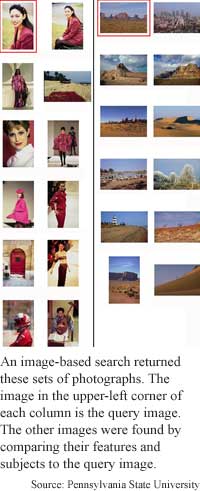
Image
search sorts by content
By
Chhavi Sachdev,
Technology Research NewsIf you’ve ever tried to search for a picture on the web, you know it’s a hit-and-miss affair. You type in some words, but only retrieve those images that contain the search terms in their meta tags or file names.
Some digital image libraries, on the other hand, let users search on the content of the images themselves. One problem with these libraries is keeping searches manageable across thousands of images.
A group of researchers at Pennsylvania State University has come up with software that maps images’ key features and assigns the images to several broad categories. The Semantics-sensitive Integrated Matching for Picture Libraries (SIMPLIcity) system retrieves images by matching the features and categories of a query image to those of images stored in the database.
The system could cut the time and expense involved in sifting through large databases of images in biological research, said James Z. Wang, an assistant professor of Information Sciences and Technology and Computer Science and Engineering at Pennsylvania State University. It could also be used to index and recover images in vast museum and newspaper archives, he said.
To use the program, a user gives it a query image or image URL. The program indexes the image by converting it to a common format and extracting signature features, such as color, texture and shape of certain segments. These features are stored in a features database while the whole image is relegated to a system database.
Images are also classified semantically - as graph or photograph, textured or non-textured, indoor or outdoor, and objectionable or benign, he said. “We first extract features. Then we use semantics classification to classify images into categories. Then within each category, we retrieve images based on their features,” Wang said.
After feature extraction and classification, the program “can tell that a picture is of a certain semantic class, such as photograph, clip art, indoor, [or] outdoor,” he said. Although it is still impossible for it to tell that the picture is about a horse, given a picture of a horse, the program can find other images with related appearances, he said.
It does this by matching the most similar areas and features of an image and comparing the remaining areas in the query image. In this way, all the areas of a query image are considered and the similarity of the query image to the database images is based on the entire image.
“An image with 3 objects is like a set of 3 points, each with a significance, in the feature space. Now the question is how to match two sets of points,” said Wang. A region-matching algorithm uses assigned significance of features in each region to do this, he said. The program’s matches remain consistent even when query images are rescaled or rotated, he said.
It takes a couple of seconds to put all the images in a database of 200,000 images in order, Wang said. “Based on the interface, the system can provide a collection of best matches,” he said. According to Wang, the image retrieval system is more accurate and substantially faster than others available today.
The image retrieval system is one of several to have emerged in recent years, said Tomaso Poggio, a professor of Brain Sciences at the Massachusetts Institute of Technology. Although the system may be an improvement over previous systems, “I do not see any major breakthrough,” he said. “The intermediate semantic level makes sense but the list of semantic categories is arbitrary [from] what I can judge. It may be interesting to try to ground it in … studies of human subjects… to evaluate whether people do the task based on semantic level categories,” he added.
The program is currently used in several universities, Wang said. “Most of them are using SIMPLIcity to search for stock photos, pathology images, and video frames,” he said. The system could be in wide use within 10 years, he said. It is not likely to ever replace human skills completely, especially with much bigger image collections, he said. “I would not know how long it will take to develop a system suitable to search hundreds of millions of images” such as on the Internet, he said.
The researchers are continuing their search for more efficient image retrieval techniques, said Wang. “At the same time, we plan to apply our systems to domains such as biology and medicine.”
Wang's research colleagues were Jia Li at Penn State University and Gio Wiederhold at Stanford University. They published the research in the IEEE Transactions On Pattern Analysis And Machine Intelligence, September 2001 issue. The research was funded primarily by the National Science Foundation (NSF).
Timeline: >10 years
Funding: Government
TRN Categories: Computer Vision and Image Processing; Databases and Information Retrieval; Pattern Recognition
Story Type: News
Related Elements: Technical paper, "SIMPLIcity: Semantically-Sensitive Integrated Matching for Picture Libraries" in IEEE Transactions On Pattern Analysis And Machine Intelligence, September 2001; “Scalable Integrated Region-based Image Retrieval using IRM and Statistical Clustering,” presented at the Joint Conference on Digital Libraries (JCDL ’01), held in Roanoke, VA, June 24-28, 2001.
Advertisements:
September 26, 2001
Page One
Statistics sniff out secrets
Quantum bit withstands noise
Image search sorts by content
Study finds Web quality time
Powerless memory gains time

News:
Research News Roundup
Research Watch blog
Features:
View from the High Ground Q&A
How It Works
RSS Feeds:
News
Ad links:
Buy an ad link
| Advertisements:
|
 |
Ad links: Clear History
Buy an ad link
|
TRN
Newswire and Headline Feeds for Web sites
|
© Copyright Technology Research News, LLC 2000-2006. All rights reserved.